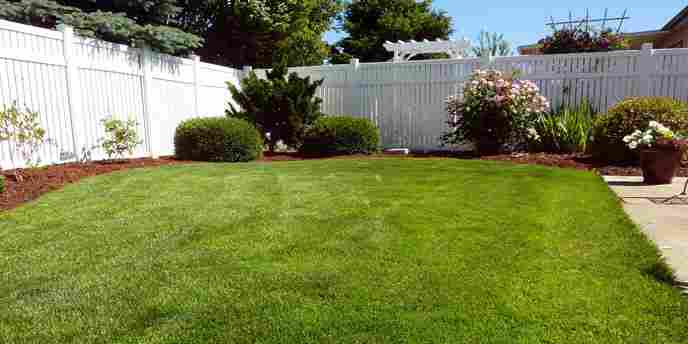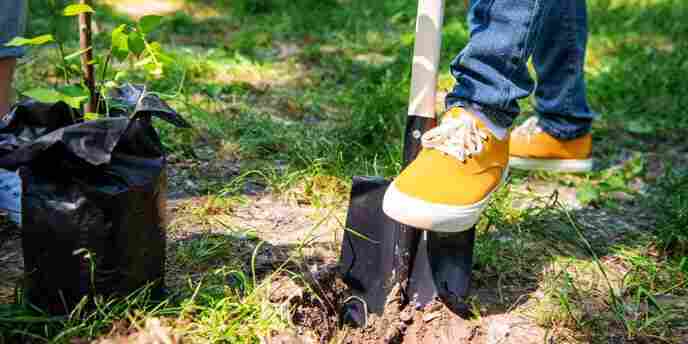How to Plant Trees in Your Backyard
Planting trees in the backyard is a great way to add beauty, shade and privacy to any landscape. But if done incorrectly, your new greenery might not make it through the winter. That’s why the best way to plant a tree is to do it right the first time.
If you’re not sure how to plant trees correctly, don’t worry. Our step-by-step guide, complete with tree planting tips from the Arbor Day Foundation and other urban forestry experts, will show you how it’s done.
How to Plant a Tree Step by Step
Tree Planting Tools and Materials
1. Find the Right Spot

One of the most important tree planting tips is to create a solid foundation for your new foliage. To find the best spot for your tree to grow and thrive, you’ll want to know a few things about your tree first.
The City of Pella, Iowa recently rolled out a 2018 Tree Rebate program to encourage urban tree planting. We asked Community Services Director Jeanette Vaughan about things to keep in mind when choosing a spot for a tree:
Tree Planting Tips: Know Your Tree’s Requirements
Sunlight: Sunlight helps trees photosynthesize. Some trees need full sunlight (more than six hours a day), while others can live with less. Find a spot that provides enough light for your tree.
Moisture: To keep a tree’s roots healthy, it’s important to plant them in an area with the right moisture levels. If your tree needs drier soil, find a spot in your yard that’s well drained. If it prefers soil that’s wetter, place it in the lowest spot of your yard, where rainwater collects.
Height: “Trees GROW,” says Vaughan. “Keep in mind the mature size of the tree when picking a location for planting. Stay away from power lines and underground utilities.”
Canopy: The canopy is the top layer of leafy cover on your tree. Some tree’s canopies can grow to be very wide, so make sure your tree has room to grow up and out.
Root Spread: A tree’s roots can be large and powerful. They can even cause foundation damage if planted too closely to your home. “Keep your tree away from the edges of sidewalks or driveways so that the roots do not heave your concrete or asphalt,” says Vaughan. “Roots also like to grow into water and sewer lines so steer clear of those areas as well.”
Jeanette Vaughan | City of Pella, Iowa
Additionally, you’ll need to decide whether you’ll be planting bare-root trees or planting container trees.
We asked the experts at the Arbor Day Foundation to explain the pros and cons of each:
Bare-Root Trees
| Pros | Cons |
|
|
Container Trees
| Pros | Cons |
|
|

Pete Smith | Arbor Day Foundation
2. Dig the Hole

When it comes to the perfect tree planting hole: “Wider is better, deeper is not!” says Smith.
Digging For Bare-Root Trees: Your hole should be large enough for its roots, but should not be deeper than the graft union. The graft union is the large notch on the trunk near the base of the tree – it’s the point where your tree was grafted onto another plant’s rootstock.
Digging For Container Trees: The hole needs to be wide enough to allow the roots to grow, but shallow enough to let oxygen and sunlight to reach the tree’s base.
To find the perfect depth for your container tree, measure the root ball, says Bryan Spencer. Spencer is the Parks & Forestry Superintendent of Oconomowoc, Wisconsin, a city that has been nationally recognized as a Tree City USA Community by the Arbor Day Foundation since 1993.
Tree Planting Tips: Measure the Root Ball to Find the Right Depth
“Make the hole two to three times wider than the size of the ball. Find the root flare – the place where your tree begins to widen at the base – and measure from there to the bottom of the ball. That should be the depth of your hole, minus about an inch to allow for watering and settling. Lay a shovel handle over the hole to make sure the ground hits the tree below the root flare.”
Bryan Spencer | Oconomowoc Forestry Division
If you’re in the middle of a landscaping overhaul, there are many ways to dispose of the bramble. Find the best yard waste disposal solution for your backyard makeover.
3. Prepare the Roots
The health of your tree’s roots will determine the health of your tree down the line, so this step is key for knowing how to plant trees successfully.
Root Prep for Planting Container Trees: Loosen the root ball to promote strong growth after planting. If the roots are tightly coiled around each other, prune the bottom of the root ball until they are free. This will prevent circling roots, which can starve the tree of water and important nutrients.
Root Prep for Planting Bare-Root Trees: Soak the roots in water for one to two hours before planting. If the roots are extremely dry, soak them overnight. Do not soak them for longer than 12 hours. Prune the roots just before planting to encourage new growth.
Tree Planting Tips: Don’t Carry Container Trees by the Trunk
“ Handle container trees carefully by the root ball . If you jostle the trunk around, you could break up the root ball. Once the root ball is broken up, it exposes the roots to air which can dry out the tree and create stability issues.”
Bryan Spencer | Oconomowoc Forestry Division
4. Plant Your Tree
Now it’s time for the main event – planting your tree.
Before filling in the soil, make sure the tree is completely straight. Have a friend walk around while you hold the tree in place to ensure it isn’t leaning to one side.
How to Plant Container Trees:
How to Plant Bare-Root Trees:
Tree Planting Tips: Common Tree Planting Mistakes
We asked the Arbor Day Foundation for a list of common mistakes made while planting trees:
Planting the Root Ball Too Deep : The first tree roots should be visible at ground line.
Adding Fertilizer: Your new tree won’t want to expand its roots beyond the rich soil, which can stunt its growth. “Just use the soil from the hole,” says Smith.
Not Watering Right Away: The planting process is a stressful ordeal for a new tree; be sure to water it immediately after planting.
Not Protecting the Trunk: Remove all grass near the trunk and add mulch to protect it from mowers and string trimmers.
Pete Smith | Arbor Day Foundation
5. Mulch and Water Your Tree
Once you’ve filled in your soil, it’s time to give your tree a little TLC.
Create a ring of mulch around, but not over, the base of your tree. “So many homeowners create a ‘volcano’ of mulch around the trunk, but this can harm the tree down the line,” says Spencer.
“Create a donut of mulch around the tree instead.”
Water your tree generously inside the mulch ring. This will concentrate the water near the base of the tree and help release the mulch’s nutrients into the soil. Watering your new tree thoroughly can also remove air pockets that might have occurred during the planting process.
Tree Planting Tips: Don’t Stake Your Tree Down Unless Necessary
“Generally, you don’t need to stake trees. But if you do, do not stake it for longer than one year . If you do, it won’t allow your tree to develop a flexible trunk. This can create a weakness point in the trunk which can cause it to snap during high winds.”
Bryan Spencer | Oconomowoc Forestry Division
Tree Planting Guide: Frequently Asked Questions
How much does it cost to plant a tree?
Planting a tree is a fairly inexpensive backyard project . Most of the costs are in buying the tree itself, which can range from as low as $20 to $100 or more, depending on the tree and the nursery you purchase from.
Tree maintenance and pruning can be expensive if your tree ends up becoming too large for its location or is not suited for your local climate. To keep maintenance costs low, purchase a tree that will do well without much extra help. “The best advice for beginners is to choose trees that are native to the area in which they live,” says Vaughan.
“Check with your local Department of Natural Resources, as they typically have tree lists available that can help folks pick the best tree for their area.”
What’s the best time to plant container trees?
Container trees should be planted in the spring or fall, well before summer or winter temperatures set in. This allows your tree’s roots to take hold without the stress of seasonal highs and lows taking their toll.
What’s the best time to plant bare-root trees?
Early spring or late fall. Bare-root trees must be planted while dormant after their leaves drop and before their buds sprout. Because bare-root trees have no soil to protect their roots, it’s important to plant them soon after receiving them. It’s a good idea to have your location picked and the hole dug before your tree arrives.
How often should I water my new tree?
Newly planted trees should be watered once a day for the first two to three weeks, and then once a week for the next year. Usually, trees need about 10 gallons of water per inch of trunk diameter. So, if your tree’s trunk is 2 inches around, it will need about 20 gallons of water per day.
Since a standard garden hose pushes about 17 gallons of water per minute , you will need to water your tree, using no attachments, for just over a minute to hit its daily 20-gallon minimum.
How do you grow a tree from a seed?
Growing a tree from a seed is doable, but it’s a little more complicated than you might think. Most seeds are dormant and need to be stratified before being planted. This means that they must spend time in cold, but not freezing, temperatures in order to reach their growth stage.
There are two ways to plant a tree from a seed: the natural method or assisted germination.
The Natural Method: Sow seeds in late autumn, typically about one inch deep in the soil. This allows the seeds to undergo the stratification process naturally during the cold winter months.
Assisted Germination: Seeds must be refrigerated to mimic the effect of a cold winter. Place your seeds in a sealed plastic bag with a moist paper towel and place it in the refrigerator at around 33 to 38 degrees Fahrenheit for a period of one to three months – the length of time will depend on your tree species.
Once stratification is complete, your seeds can be planted and grown wherever you’d like in your backyard. For a more in-depth tree planting guide for this method, check out these tips from the experts at Tree Help for how to plant a tree from a seed .
Planting Trees: The Greenest Home Improvement of All
There is no greener home improvement project than planting a tree. From providing homes and shade to helpful local wildlife to cleansing the air around them, the list of benefits trees provide is long.
So if you’re looking for a way to add beauty and value to your home while giving back to Mother Nature, it’s time to start digging.
Looking for tips on how to maintain your new foliage and the rest of your yard? Check out How to Create a Beautiful Backyard .
Finished planting your new tree? Post a picture in the comments!
Your comment